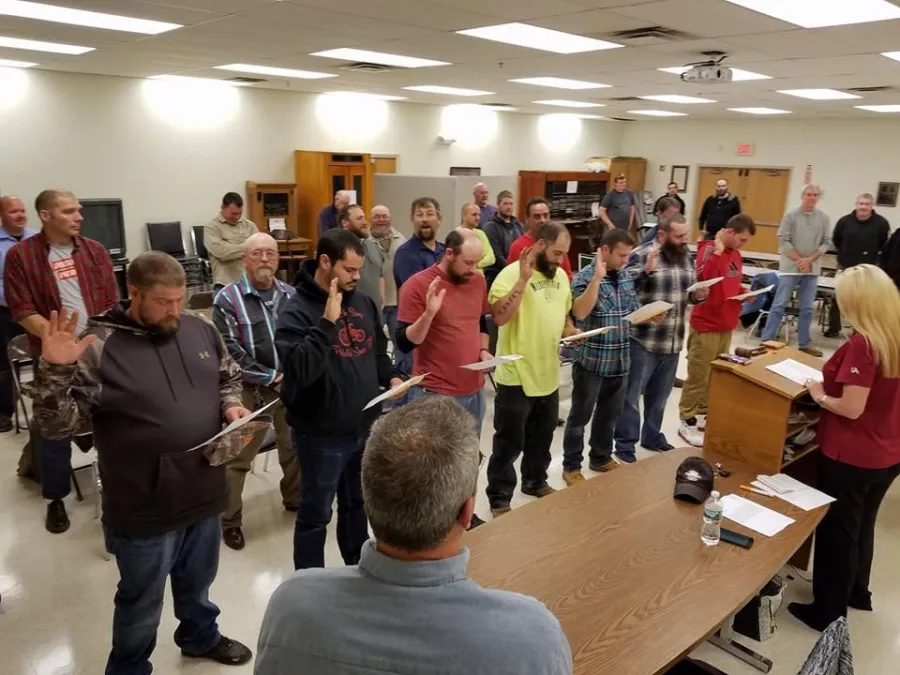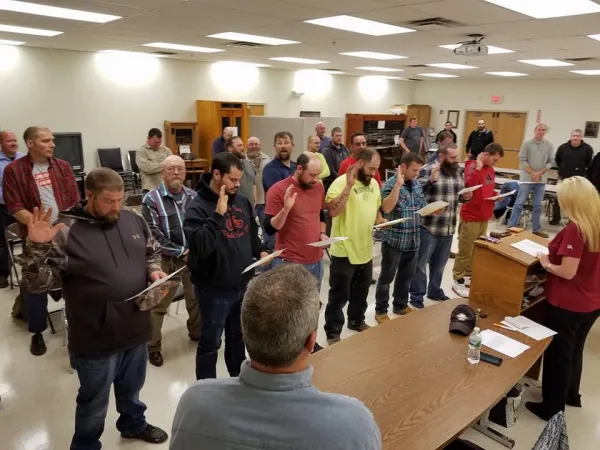Maine UA Plumbers & Pipefitters Celebrate 115 Years


On the evening of June 9, 1904, 14 union men were initiated into the Plumbers and Pipefitters, Gas Fitters, Steam Fitters and Steam Fitters Helpers’ Union Local 217 at its first meeting at Congress Hall in Portland. The new members elected Mike O’Sullivan as the first president. On December 7th, UA Plumbers and Pipefitters members from across the state will gather with their families in Augusta to belatedly celebrate the union’s 115th anniversary.
The roots of the Plumbers and Pipefitters go all the way back to the 1820s and 30s when skilled craftsmen formed guilds and societies to teach skills, establish fraternal bonds and advocate for safer working conditions, shorter work days and economic equality for working people. Plumbers and gasfitters first established unions in New York and Chicago in 1850 and many became organized under the Knights of Labor banner in the 1880s.
Back in Maine, the Portland Central Labor Union announced that it had organized the Pipers, Plumbers and Metal Workers UnIon on February 17, 1893. The new union local immediately began pushing for stronger city standards for the plumbing trade to protect the health and safety of residents. Two years later the plumbers founded a state-wide organization.
Maine union plumbers were know for their hard work ethic and they supposedly made a good living, but they weren't afraid to fight back when they were mistreated. Reporting on a strike in Bangor on June 11, 1902, the Kennebec Weekly Journal reported, “The strike of Bangor plumbers for higher wages makes havoc with another cherished tradition. It was supposed that the plumber was so rich they the did not have to strike."
The strike was brief, both the union and employers agree on a scale of wages.
Prior to 1889, union plumbers, steamfitters and gas fitters were members of independent local unions with either no affiliation, or affiliation with a variety of trades. In the 1880s union members began to discuss ways to unite the pipe trades to address a range of issues from supporting traveling members to building apprenticeships and providing strike aid. Then in 1889 a Boston plumber named P. J. Quinlan sent a letter to fellow plumber Richard A. O’Brien in Washington D.C.:
"Dear Sir and Brother," he wrote, "I take the liberty of addressing a few lines to you to obtain your views as regards the formation of a United Brotherhood."
The seed was planted and on October 11, 1889, the United Association of Journeymen Plumbers, Gas Fitters, Steam Fitters and Steam Fitters' Helpers of the United States and Canada was born. Eight years later the union affiliated with the American Federation of Labor (AFL).
The New Deal & War Years
Over the next three decades, UA membership grew until the Great Depression of the 1930s threw millions of people out of work, causing untold economic pain on families and destroying workers’ sense of pride and self worth. Then President Franklin D. Roosevelt brought hope to the nation by launching the New Deal. FDR’s Public Works Administration (PWA) and Works Progress Administration (WPA) put thousands of Mainers to work building 122 schools as well as upgrading sewers, bridges, airport runways, roads, sidewalks, municipal buildings, wading pools, playgrounds, and parks.
By 1941, national UA membership had reached 81,000 and then soared to 210,000 during World War II as they went to work in shipyards of Bath and South Portland. During those years, the UA was able to secure national agreements with large, national contractors to ensure the work was done safely using skilled professional craftsmen. George Meany, who was a member of UA Local 2 in New York City, became the first president of the AFL-CIO in 1956.
Still Going Strong!
In 1997 the three locals in Bangor, Lewiston and Portland merged into one statewide union, Local 716, based in Augusta. Today it is still going strong with 500 members. Everyday Local 716’s members perform industrial work in paper mills, power houses and schools as well as residential plumbing and heating.
Currently, Local 716 is expanding its plumbing and HVAC training programs to provide moreservice toresidential and business clients. UA 716 is also aggressively organizing new members and just unveiled its new website plumbers911maine.com, which helps homeowners connect to skilled professional plumbing and heating technicians.
“We want to grow our service sector because that keeps people busy,” said UA 716 business agent John Napolitano. “On the service side, you get people working 40 hours a week, 52 weeks a year. On the construction side you have seasons and it’s hard to keep people busy on the construction side during the winter.”
On the legislative front, the union is working with the Building Trades to pass a state Responsible Contracting law that will put in place safety and apprenticeship requirements along with mandating Project Labor Agreements for large state-funded construction projects.
From its humble beginnings with 14 members in 1904 and their tireless advocacy for high road, skilled jobs that pay living wages with benefits, the Plumbers and Pipefitters have been an inspiration to all workers in Maine. Happy 115th anniversary brothers and sisters!
